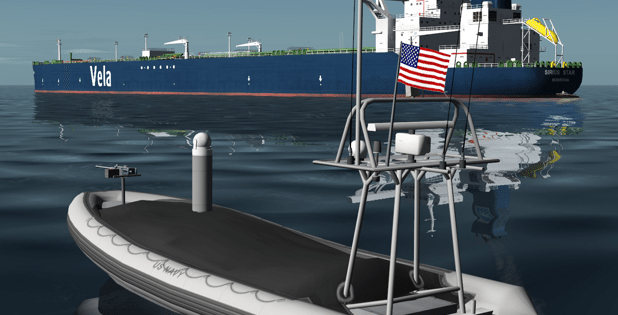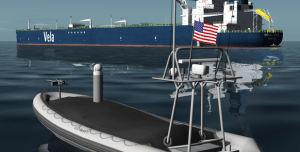 Drone aircraft, officially called unmanned aerial vehicles (UAVs), are just starting to be used to spot, identify, scare pirates away, and prevent hostage situations. But what about the “latest” generation of unmanned systems, unmanned surface vehicles? USVs could be launched from any yacht, ram into the assailing pirates’ skiff, or be launched from a tanker to conduct armed operations against the pirates five miles away from the tanker.
Drone aircraft, officially called unmanned aerial vehicles (UAVs), are just starting to be used to spot, identify, scare pirates away, and prevent hostage situations. But what about the “latest” generation of unmanned systems, unmanned surface vehicles? USVs could be launched from any yacht, ram into the assailing pirates’ skiff, or be launched from a tanker to conduct armed operations against the pirates five miles away from the tanker.
According a recent MIG report titled “Unmanned Maritime Systems – UAV & USV Outlook 2012 – 2020“… they can, but they won’t.
The report suggest a number of problems with the use of unmanned systems. First, the international maritime laws & rules of engagement tightly control the use of weapons at sea. Second, the launch and recovery of the USV can be problematic. Third, the expertise required to conduct a USV operation is out of reach for most commercial seafarers, and poses issues of liability, costs, training, etc.
What is the current state of naval USV technology?
While each maritime power is taking a different view on the development of USVs, the US Navy has identified four types of vehicles for further study:
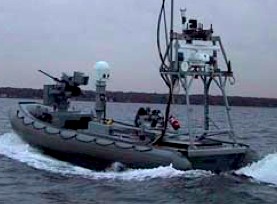 X-CLASS (SMALL) – The X-Class is unique in that these small, special purpose craft should be purpose-built and not standardized for modularity. But the navy believes to do so would not be cost-effective or efficient due the small size of the craft and the overhead associated with modular construction. The other three classes all benefit from modular construction and all four classes plan to utilize a common command and control system. The X-Class Unmanned Surface Vehicles are about 3 meters in length or smaller and built to support the needs of SOF Support and MIO Support. They have limited endurance, payload, weapons capability and sea-keeping ability.
X-CLASS (SMALL) – The X-Class is unique in that these small, special purpose craft should be purpose-built and not standardized for modularity. But the navy believes to do so would not be cost-effective or efficient due the small size of the craft and the overhead associated with modular construction. The other three classes all benefit from modular construction and all four classes plan to utilize a common command and control system. The X-Class Unmanned Surface Vehicles are about 3 meters in length or smaller and built to support the needs of SOF Support and MIO Support. They have limited endurance, payload, weapons capability and sea-keeping ability.
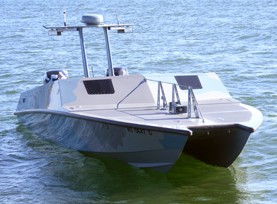 HARBOR CLASS (7M) – The Harbor Class USVs use a 7 meter RIB as the sea-frame and is capable of being operated in both manned and unmanned modes. The requirements for the Harbor Class are driven by the US Navy’s need for them to be hosted by the majority of warship platforms and to perform advanced ISR and Maritime Security missions. The ISR payload will be arch-mounted such that it can remain in place for manned operation of the craft. Robust electronic warfare, advanced sonar, and deployable payload technologies are also needed to support this class.
HARBOR CLASS (7M) – The Harbor Class USVs use a 7 meter RIB as the sea-frame and is capable of being operated in both manned and unmanned modes. The requirements for the Harbor Class are driven by the US Navy’s need for them to be hosted by the majority of warship platforms and to perform advanced ISR and Maritime Security missions. The ISR payload will be arch-mounted such that it can remain in place for manned operation of the craft. Robust electronic warfare, advanced sonar, and deployable payload technologies are also needed to support this class.
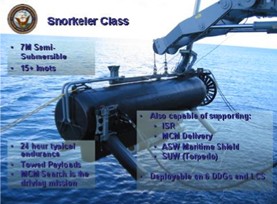 SNORKELER CLASS (7M SS) The Snorkeler Class USV is a 7 meter semi-submersible craft operated off a large navy warship platform and designed for a wide range of future operational capabilities. During operation the Snorkeler Class USV is submerged with only its snorkel above the surface. This mode of operation provides a stable platform in high sea states and inclement weather than other surface hull types. The need for for this class is driven by the MCM Search/ Neutralization and ASW missions of the United States Navy.
SNORKELER CLASS (7M SS) The Snorkeler Class USV is a 7 meter semi-submersible craft operated off a large navy warship platform and designed for a wide range of future operational capabilities. During operation the Snorkeler Class USV is submerged with only its snorkel above the surface. This mode of operation provides a stable platform in high sea states and inclement weather than other surface hull types. The need for for this class is driven by the MCM Search/ Neutralization and ASW missions of the United States Navy.
 FLEET CLASS (11M) – The Fleet Class USVs are 11-meter planing or semi-planing hull craft. They provide moderate speed/endurance while towing MCM sweep gear or high speed and very long endurance to support ASW, SUW, or EW missions. This option is provided by a modular propulsion system. They also support manned operation through the ability to remove and replace their mission systems in less than 24 hours.
FLEET CLASS (11M) – The Fleet Class USVs are 11-meter planing or semi-planing hull craft. They provide moderate speed/endurance while towing MCM sweep gear or high speed and very long endurance to support ASW, SUW, or EW missions. This option is provided by a modular propulsion system. They also support manned operation through the ability to remove and replace their mission systems in less than 24 hours.
The US Navy expects unmanned systems, and Unmanned Surface Vehicles in particular , will provide multiply available force while lowering risk to manned vessels and personnel. These factors could potentially enable a smaller Navy to address widening Navy requirements including anti-piracy missions.
With the Navy’s USV program advancing slowly, what is the overall future of these vehicles in relation to maritime security threats in Somalia?
When launched from a host naval ship, USVs may be an effective tool to increase intelligence, surveillance and reconnaissance (ISR) coverage. Naval professionals are becoming increasingly comfortable with the use of unmanned maritime vehicles. A host of non-lethal and surveillance-only options are likely to be used until lethal weapons are an absolute necessity. The USV can be used to patrol an area on an almost-persistent basis, enabling it to provide a quick response and alert ships in advance of pirates boardings. Plus electronic data collected by USVs could be assist naval intervention units at sea – and be later use for litigation. In face of the growing violence of the Eastern African pirates, it is reasonable to assume that they will gradually become more adept at carrying out night raids.
While USVs are not a panacea to modern piracy, the report suggests that unmanned vehicles will gradually become part of the overall maritime piracy strategy in both defensive and offensive capacities.

 Join The Club
Join The Club



